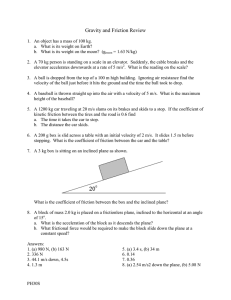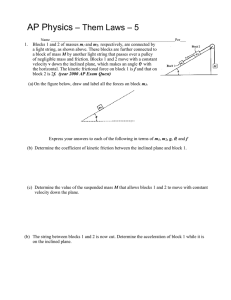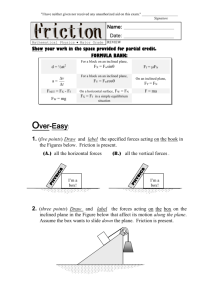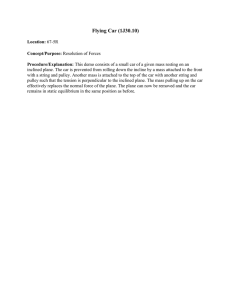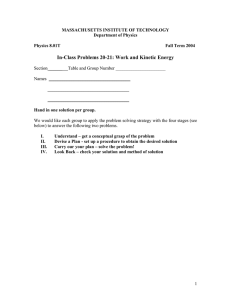Motion on an inclined plane and the nature of science
advertisement
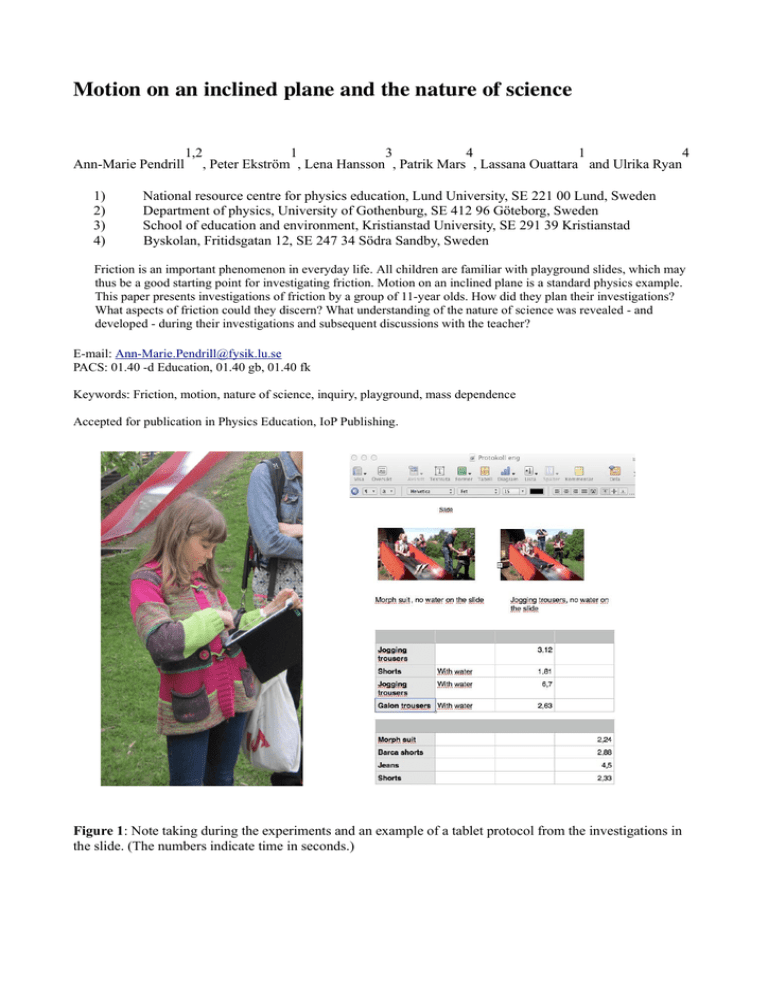
Motion on an inclined plane and the nature of science Ann-Marie Pendrill 1) 2) 3) 4) 1,2 1 3 4 1 4 , Peter Ekström , Lena Hansson , Patrik Mars , Lassana Ouattara and Ulrika Ryan National resource centre for physics education, Lund University, SE 221 00 Lund, Sweden Department of physics, University of Gothenburg, SE 412 96 Göteborg, Sweden School of education and environment, Kristianstad University, SE 291 39 Kristianstad Byskolan, Fritidsgatan 12, SE 247 34 Södra Sandby, Sweden Friction is an important phenomenon in everyday life. All children are familiar with playground slides, which may thus be a good starting point for investigating friction. Motion on an inclined plane is a standard physics example. This paper presents investigations of friction by a group of 11-year olds. How did they plan their investigations? What aspects of friction could they discern? What understanding of the nature of science was revealed - and developed - during their investigations and subsequent discussions with the teacher? E-mail: Ann-Marie.Pendrill@fysik.lu.se PACS: 01.40 -d Education, 01.40 gb, 01.40 fk Keywords: Friction, motion, nature of science, inquiry, playground, mass dependence Accepted for publication in Physics Education, IoP Publishing. Figure 1: Note taking during the experiments and an example of a tablet protocol from the investigations in the slide. (The numbers indicate time in seconds.) 1. Introduction What clothes are best for going down a slide? Already small children are aware that rain clothes on a wet slide give a fast ride. Children may refer to their clothes as "fast" and "slow" and a preschool teacher may possibly introduce them to the word "friction". In this paper, we present an open investigation on a playground, performed by a group of 11-year-olds supported by their teachers, and joined by a group of researchers. What aspects of friction could be discerned by the pupils in these investigations? A total of 12 pupils, divided in two groups, performed the experiments in different order. One group starting by going on the playground slide, while the other investigated blocks on an inclined shelf plane. The pupils had been asked to bring three different types of clothes for riding on the playground slide. The teacher had also brought a bottle of water. After everyone had gone on the dry slide, the experiment was repeated first with water and then with sand on the slide. Ipads were used by the pupils for the documentation, enabling small movies to be inserted in the protocol, in addition to measuring and writing down the time required for rides under different conditions (Figure 1). The teachers had also brought a crate with four blocks of wood covered with different fabrics to be tried on a shelf plane. The crate with equipment included a measuring rod and an extra piece of one of the fabrics. 2. Measuring the slope of the inclined plane. After an initial investigation of the material available, and touching the different fabrics, the first action taken by the group was to put one block at the time on the plane and lift one end until the block started sliding, while measuring the height of the free end as an indication of the slope of the plane. (Figure 2a-b). Figure 2: Blocks covered with different materials (a) and measurement of the slope where a block starts sliding (b). The photo in (c) shows a comparison between two blocks sliding with different sides toward the plane. After measuring the different heights at which the four blocks starts sliding, the pupils were given some hints to try putting the block on the plane in different ways. Does it matter whether the block lies with the narrow side or broad side on the plane? The measurements indicated small differences. The teacher brought up the question of fair tests, and the pupils noticed that the ground was slightly uneven and that it was important to hold the measuring rod vertically. After some discussions and gentle prompting by one of the researchers the idea came up to compare the two cases simultaneously, rather than measuring the slopes individually. Since there was only one block of each kind, a copy was improvised using the spare cloth and a ponytail rubber band offered by one of the girls. The improvised cover of the block was not quite as tight as the original one (Fig. 2c). This was discussed as a possible cause for small differences observed. The pupils were also encouraged to repeat the experiment. They noted that sometimes a block seemed to get stuck. Static friction is, indeed, referred to as "stiction" in some contexts. The sticking can lead to relatively large variations in the resulting angle. The continued investigations focused instead on comparing different blocks in a race down the plane at a slightly larger angle. (Fig 3). In the next section, we present a brief summary of the standard physics description of friction. Figure 3: Race down an inclined plane between blocks covered with different materials 3. Friction: force or coefficient? Everyday life gives many sensory experiences of friction in action, showing clearly the importance of what surfaces are involved. Anyone trying to move something across a floor knows that a harder push is needed to move a heavier object. By pressing objects together, we may sometimes prevent slipping. With standard physics notation we may note that the frictional force, F, can be expressed as F≤ µN, in terms of the normal force, N, and the coefficient of friction, µ, where the equality holds when objects are moving /1/. The inequality for static friction implies that a body remains at rest on an inclined plane as long as the angle is sufficiently small. The inequality used to express static friction often causes difficulties in traditional physics problem solving: The size and direction of the static friction force cannot be determined without knowing the other relevant forces for a given situation. An inclined plane with a slope θ exerts a normal force N=mg cos θ on a body with mass m. If the body is at rest (or moving with constant speed), the upward friction force must be F= mg sin θ to counteract the tangential component of the force of gravity. This leads to the condition for the slope: tan θ ≤ µ. For a slope with angle of inclination θ! where a body starts sliding, or slides with constant speed, the force s of friction exactly opposes the force of gravity along the plane, and we can measure the coefficient of friction as µ = tan θ = h/b, where h and b are the corresponding vertical and horizontal distances, as shown in Figure 4. Although the equations and definitions are unlikely to be accessible to young learners, the relations have some remarkable and counterintuitive consequences that can be appreciated and investigated much earlier, as discussed below. A first observation is that the surface area does not enter the expression for the friction force. A second observation is that the slope at which a body starts to slide is independent of the mass. Since the frictional force, like gravity and inertia, is proportional to the mass of a sliding object, all terms in the equation of motion for the body on an inclined plane are proportional to the mass. Thus, the mass should not affect how fast an object slides down a plane. This knowledge helps the teacher provide scaffolding for the investigations and discussions Figure 4: The slope can be expressed in terms of an angle, θ, where tan θ = h/b. 4. Friction and motion down an inclined plane The materials of the two surfaces in contact clearly influence whether something slides and how fast. Can other factors affect the motion? For the race between four blocks, as in figure 3, the blocks needed to stand on the edge on the shelf that was used as an inclined plane. Would that make the blocks go faster or slower? Intuitively, a larger area would give larger friction, causing a slower motion, in contradiction to the equations. The comparison could easily be made with the two blocks covered by the same material sliding side by side. Their motions were found to be very similar. Identifying factors that may influence the motion is important. However, it is also important to recognize factors, such as the size of the contact area, discussed above, that do not influence the motion. The selection of blocks taken along for the investigations determine what factors can be varied and investigated. Is colour important? This question could not be investigated experimentally with the equipment available. A possible addition could have been to bring two pieces of fabric in the same material but different colour. Most adults do not expect that the colour of the material would be important for friction, but this could be a possible factor brought up by pupils, depending on previous experiences. What about mass? We know that it is harder to pull a heavier box across a surface. This is connected to the normal force between the box and the table. The normal force is always orthogonal to the surface. Also for an inclined plane, the normal force between an object and the plane is proportional to the mass. On the other hand, the pull of gravity along the inclined plane is stronger for a heavier object. Applying appropriate dynamic equations of motion, we can conclude that mass should not play a role. Could the conclusion be accessible without knowledge of the mathematics involved in the situation? Students may possibly come u p with thought experiments, where two blocks sliding side by side should not move differently if glued together. A possible topic for discussion could be whether heavy adults can move up steeper slopes than children or vice versa. An investigation was easy to perform on the playground by comparing a single block with a block with one or two other blocks on top (Figure 5). The pupils noted small differences - could these be significant? The teachers suggested that a doubling or tripling of mass could be expected to give more noticeable effects, if mass were important. One of the students suggested that they should look for a heavy stone to put on the block for comparison - applying the useful principle of extrapolation to limits. After a little search around the playground, the experiment could be performed with a heavy stone on one of the blocks, confirming the noninfluence of mass. During the group discussion at the end of the lesson the students also questioned their result, comparing to their experiences from sledding on snow. Figure 5: How does mass influence the motion on an inclined plane? After a comparison between three blocks and one block an even larger difference was tried. A final investigation involved the distribution of mass. 5. Follow-up discussions in the classroom A couple of days after the experiments, the participating pupils were asked to summarize their findings, i.e. what influences how an object slides down an inclined plane. One of the pupils directly observed that "It is complicated" and most of the classmates agreed. The teacher aimed to ensure that everyone was involved and the quotes below come from different pupils. The discussions started with the experiences in the slide, with different clothes. It was agreed that rain trousers on a wet slide gave the fastest ride. One pupil noted that when he was younger, he always put sand on the slide to go faster. The teacher emphasized a possible contradiction: But when there is ice on the ground, you add sand to make it less slippery? On the slide, the small grains of sand start to roll, and "become like small wheels", as expressed by one of the pupils. For a while, they all agreed that you slide faster on a wet slide or on a slide with sand on it. The next contradiction was brought up by one of the pupils: But if you wear jeans on a wet slide, you go really slowly! The class had to reevaluate their first statement, and concluded that what matters is the combination of materials on the plane and what is sliding on it. At this stage, one of the pupils brought up the possibility of the mass as an explanation for different speeds on the slide: "I know, it is slow because when the jeans are wet, they get much heavier". This statement led to a new discussion about whether the mass affects the speed down an inclined plane. The teacher prompted: " If it is very heavy, it should be faster, but if it is not that much difference ... is it really faster? " and the pupils joined: "If you have no weight at all, you should slide quite quickly?" "It depends on the slope of the hill. If it is a very small slope, it has to weigh a lot, but if it is very light ..." "No, it didn't matter how heavy ..." Another pupil protested: "If you first ride, and then add 5 kg ... it will be a bit slow." One pupil connects the discussion to the observations of blocks on the plane: " We had those blocks, and when we added one more, there was no difference at all." The discussion came back to dry trousers being much faster in the slide than when you put water on and "they get heavier, too heavy". The reason they had already found for the slow ride with jeans was brought back: "No, it is because they stick ... what is wet sort of sticks to the slide" At the end of the lesson, the teachers asked the pupils to summarize what influences how fast something slides downhill. They concluded: " The materials are important " Weight - on certain surfaces " If there is something on top of the surface that can roll (e.g. sand) " The slope They also found that the size of the contact area does not influence the speed. 6. The role of the teacher In the follow-up discussions presented above, the teacher provides scaffolding, helping pupils reach higher levels of understanding of the nature of science, as described e.g. in the AAAS document "Benchmark for Science literacy" /2/. In a few important situations the teacher asks questions to focus the students' attention to apparent contradictions. After some time discussing the experience in the slide, the teacher brought the classroom discussion back to the investigations with the blocks and asked the pupils to summarize their conclusions. All of them agreed that mass did not play a role - but soon one of the pupils pointed out: "No, not there, but when you are sledding!" The teachers reminded them again of the expectation of generality of physical results: " What? Are the laws of physics different for a sled and a block? " In this way, the teacher helps the pupils remember the expectation that "when a science investigation is done again in a different place, we expect to get a very similar result"/2/. The discussions show that this connection between different situations is not automatic for all pupils: Although they investigated friction a couple of days earlier, and agreed that mass does not affect the motion, they have not necessarily modified their everyday conceptions to agree with the results of their investigations. However, one of the pupils recalled the reason for a faster ride with a heavier sled, discussed during the playground visit: "But that is because there is snow underneath, and you compress the snow, making it hard and flat". The teacher also pointed to differences between the effects of sand on slides and sand on snow or ice. The pupils were enthusiastically involved in the discussions and very interested in testing and comparing different ideas and possible situations. 7. Discussion An inclined plane offers pupils many possibilities to practice systematic investigations, and make connections to the everyday experiences of the playground slides and sledding on snowy slopes. When this group investigated blocks on an inclined plane, the focus changed from measuring the static coefficients of friction to comparisons, both of static and dynamic friction. Through comparisons, the pupils were able to discover that many factors that were expected to be important in fact played very little role, if any. They also discussed, and in some cases tried, limiting cases, e.g. what would happen in the limit of very low or very high mass. Science experiments do not always turn out as expected. A documentation of difficulties that can be expected to occur can be a safety net and help teachers prepare for the important summarizing class discussions. When observations disagree, the discussion can be quite challenging: Were the investigations done in exactly the same way or was some condition unintentionally changed? Were observations unconsciously modified to fit preconceptions? Repeated experiments can be one way to resolve questions. The Ipad documentation with films also makes it possible to go back for closer looks, both at the results and at how experiments were performed. Can a child on a slide be modelled by a block on an inclined plane? Is this a meaningful model for pupils? During the playground visit, most discussions were found to take place in the simplified model experiment. The classroom discussions, on the other hand, started with the experiences in the slide, but used results from the model experiment to make sense of everyday experiences. Friction is, indeed, complex, like many other aspects of everyday physics. In a model experiment, the selection of materials available is part of the teacher preparation, which guides and limits, to some extent, what variations of properties can be explored. The combination of materials on the blocks, the real playground slide as well as references to everyday experiences brought in by the teacher were essential to help pupils to reach more general conclusions and also understand their limitations. Acknowledgements. Partial funding for this work was provided by the Swedish National Agency for Education and by Lund University. References 1. The IUPAC (http://goldbook.iupac.org/F02530.html) recommends the term "friction factor", but we have chosen to use the more well-established term "friction coefficient" 2. Benchmark for Science Literacy, http://www.project2061.org/publications/bsl/online/index.php Authors Ann-Marie Pendrill is director of the Swedish National resource centre for physics education and professor in physics. Her research background is computational atomic physics, but her more recent work has focused on various aspects of physics and science education. She has used examples from playgrounds and amusement parks in her teaching in physics, teaching and engineering programmes. Peter Ekström is a senior lecturer at the Division of Nuclear Physics, Lund University. He maintains the extensive web site Ask-a-Physicist for the National resource centre for physics education, which includes a database of more than 6000 questions answered. Lena Hansson is a physics teacher and has a PhD in science education. She is associate senior lecturer at Kristianstad University, Sweden. In addition to doing research she works at the National resource centre for physics education with projects aiming at bridging the gap between science education research and school practice. Lassana Ouattara, has a PhD in Physics, Nanoscience, from Lund university. After a postdoc period in Copenhagen, he returned to Lund University, where he is now a lecturer at the physics department, and a project manager at the National resource centre for physics education. Ulrika Ryan, teacher at Byskolan and lecturer at Malmö University. In 2012 Ulrika won the prestigious Swedish teacher prize ”The golden apple” for her aims to digitizing math education for younger pupils." Patrik Mars is a teacher (science, math and sports) for ages 6-12 at Byskolan in Södra Sandby, since 2001. This is an author-created, un-copyedited version of an article accepted for publication in Physics Education. IOP Publishing Ltd is not responsible for any errors or omissions in this version of the manuscript or any version derived from it.

